Узнайте, что это учетную запись defaultuser0 в Windows 10 и почему вы не должны ее игнорировать! Также читайте, как отключить / удалить defaultuser0 используя lusrmgr, в этой статье.
Пользователи, работающие в Windows 10 , возможно, заметили , что в каталоге пользователей C: \ Пользователи ( C: \ Users ), есть профиль пользователя с именем ‘ defaultuser0 ‘. Если вы участник программы Windows, Insider, вы возможно, даже видели этот defaultuser0 на экране входа некоторых сборок. Теперь вопрос — почему учетная запись « defaultuser0» присутствует в Windows 10 и зачем она вам?
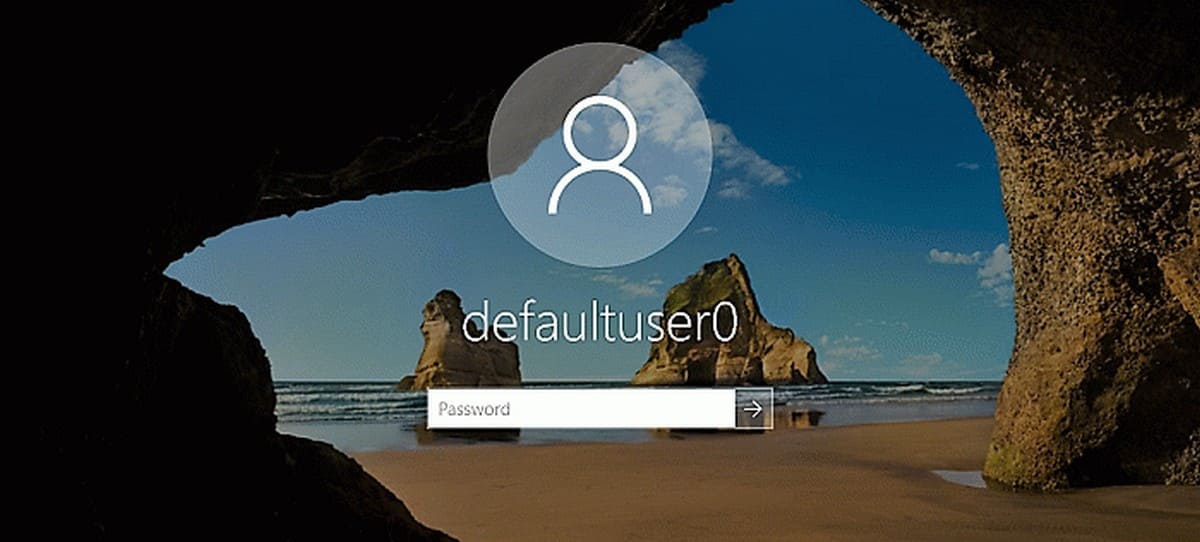
Что такое учетная запись «defaultuser0» в Windows 10 и почему вы должны заботиться о ней?
Defaultuser0 не что иное, как небольшая ошибка которая присутствует в Windows 10. Некоторые системы могут показать DefaultUser () . Это учетная запись пользователя не является не частью какой — либо группы пользователей и не имеет профиля. Учитывая все эти факты, на самом деле можно безопасно удалить его.
Но вы можете подумать, что произойдет, если вы не удалить его?
Ну из опыта прошлых лет, было замечено, что иногда defaultuser0 может создавать сложные ситуации для вас, как:
1. Вы выполнили сброс в Windows 10. Затем Windows 10 заставляет вас войти в систему как ‘ defaultuser0 ‘ (выше изображение иллюстрирует это). Но запись не имеет пароля, соответственно вход не возможен. Теперь вам придется сделать, чистую установку системы, потеряв свои данные и потратив свое время.
2. В некоторых случаях defaultuser0 снова появляется после чистой установки и все может повторится.
Как удалить defaultuser0 В операционной системе Windows 10?
Так как ‘ defaultuser0 ‘ может быть безопасно удалена, лучше всего, удалить ее, как только вы заметите ее присутствие. Тем не менее, если вы хотите сохранить эту учетную запись, необходимо, установить пароль для нее.
Вариант 1 — Удалить defaultuser0 полностью
1. Загрузите Windows 10 в безопасном режиме .
2. Откройте оснастку lusrmgr, набрав lusrmgr.msc с помощью команды Выполнить.
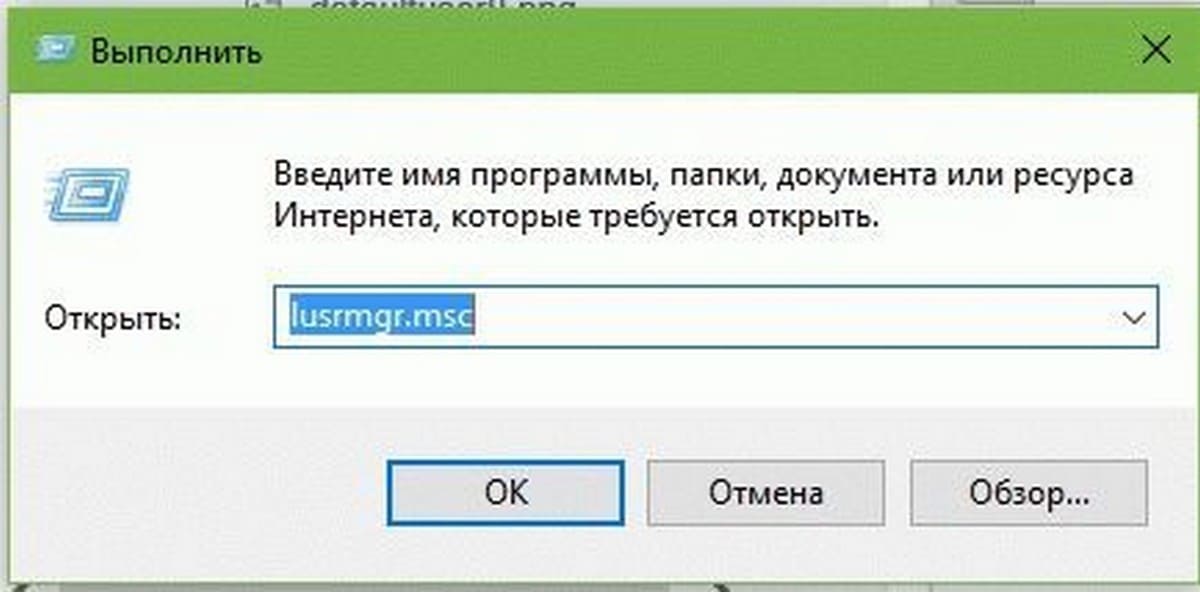
3. Откройте папку Пользователи и правой кнопкой мыши кликните на записи defaultuser0. Выберите Удалить.
Закройте оснастку lusrmgr.
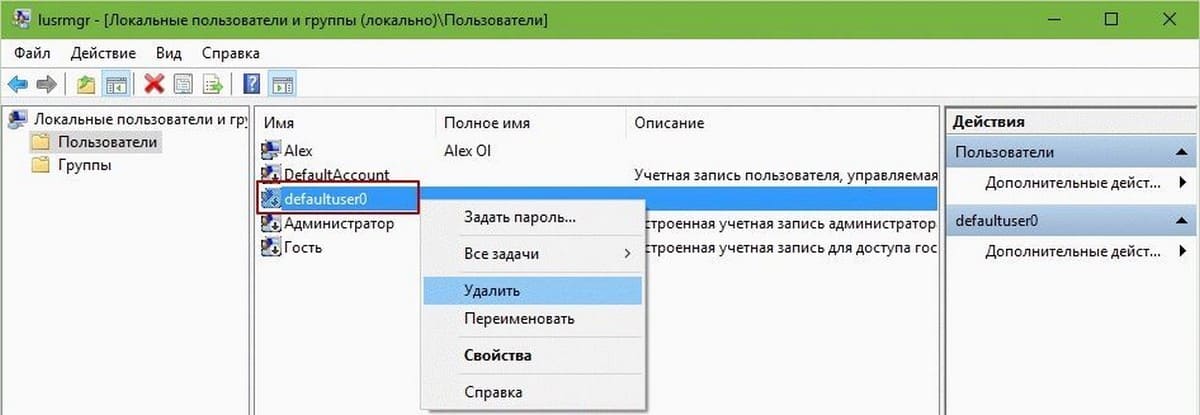
4. Перейдите C: \ Пользователи и удалите папку defaultuser0 .
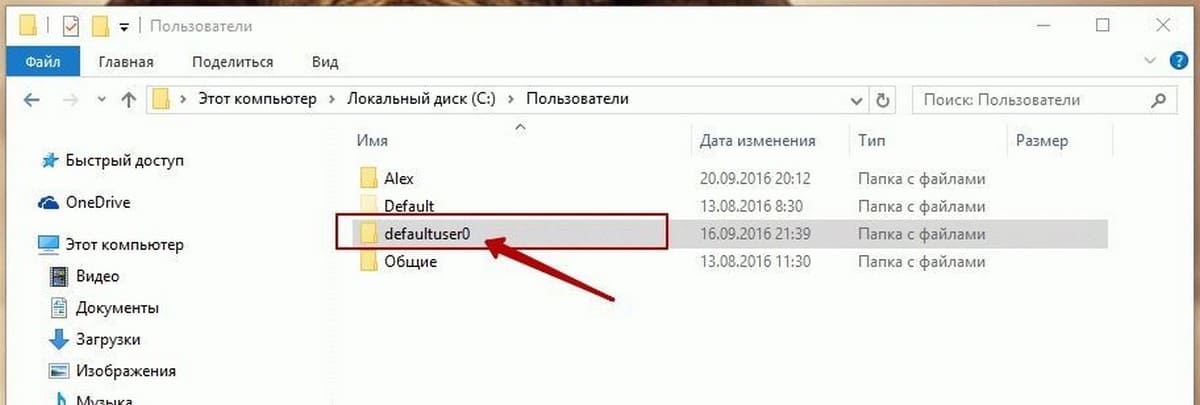
5. Нажмите Win+ R и введите Regedit в диалоговом окне Выполнить , чтобы открыть редактор. Нажмите кнопку ОК.
6. В левой панели окна редактора реестра, перейдите к следующему разделу реестра:
HKEY_LOCAL_MACHINE\SOFTWARE\Microsoft\Windows NT\CurrentVersion\ProfileList

7. Развернув раздел реестра ProfileList, вы увидите подкаталоги, начинающиеся с S-1-5 …. Выделите один за другим, и в правой панели, в строке ProfileImagePath тип ( REG_EXPAND_SZ ) ищите C:\Users\defaultuser0.
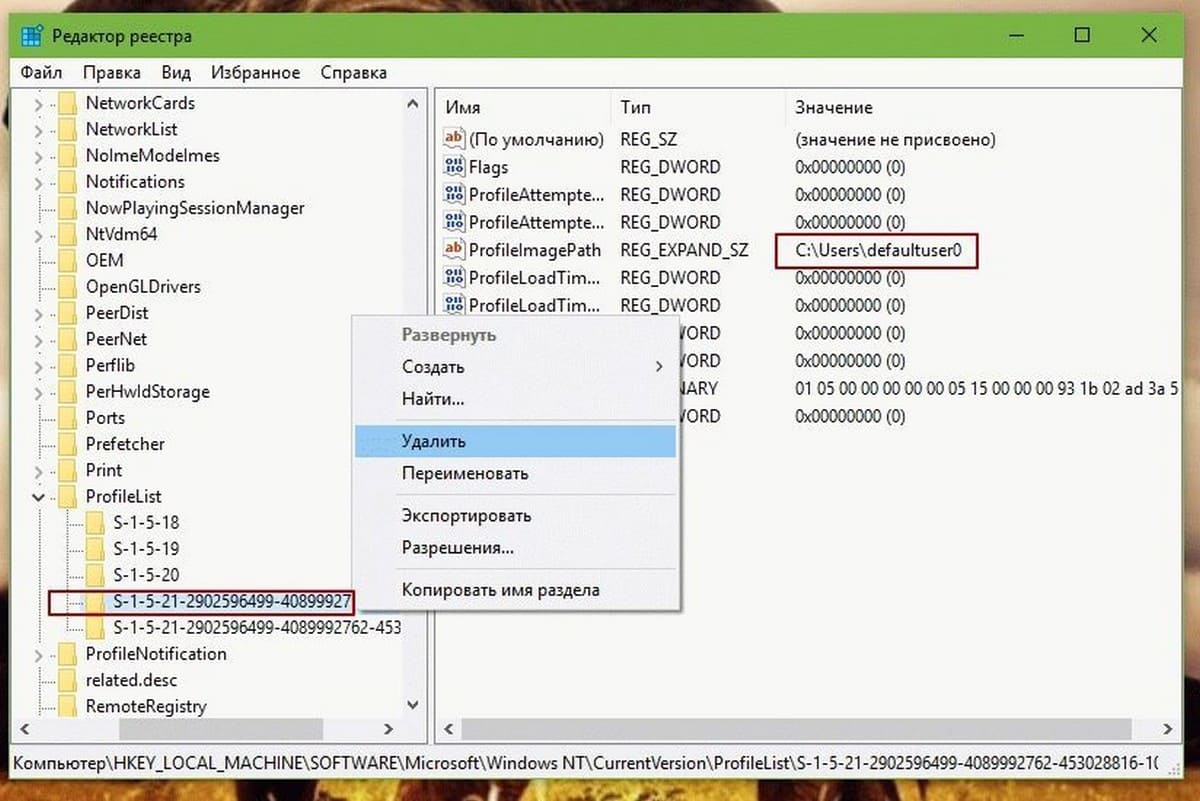
Папку в которой найдется defaultuser0 нужно удалить. Кликните правой кнопкой мыши на ней и выберите Удалить. Закройте редактор реестра. Перезагрузитесь в нормальный режим работы.
Таким образом, учетная запись defaultuser0 будет полностью удалена.
Вариант 2 — Установка пароля на defaultuser0
Если вы решили не удалять defauluser0, вы можете пойти другим путем, установить пароль для него.
1. Повторите шаги 1 и 2 из первого варианта.
2. В окне lusrmgmr, нажмите на папку Пользователи и кликните правой кнопкой мыши на записи defaultuser0, выбрав в контекстном меню опцию — Задать пароль.
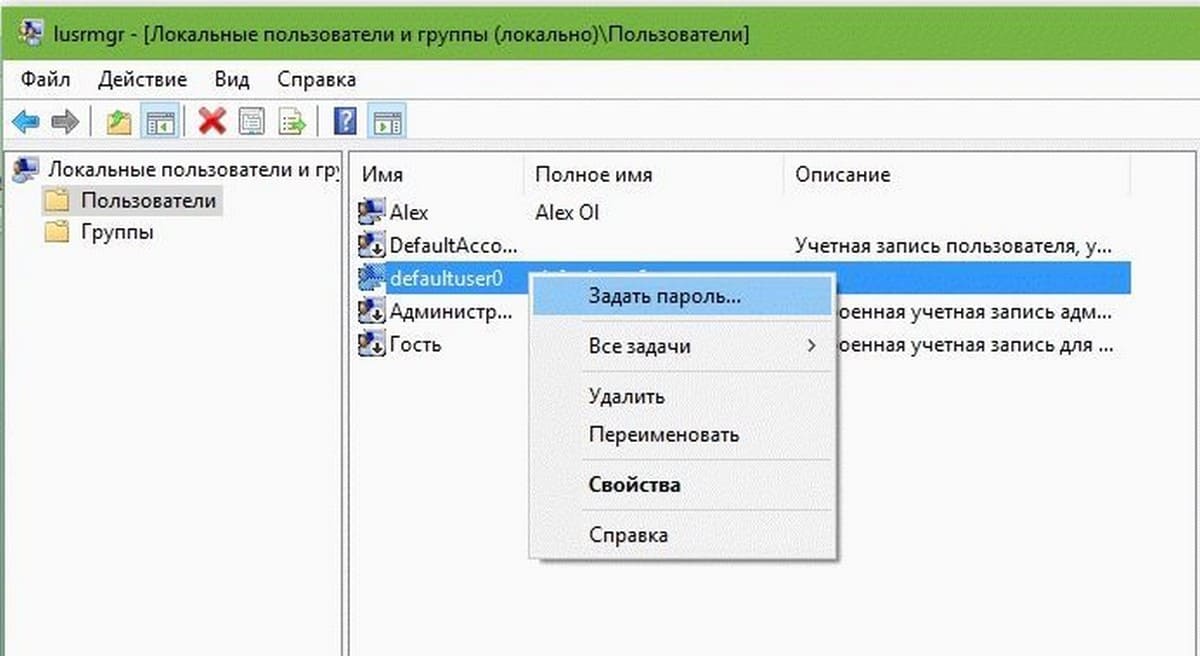
3. Затем нажмите кнопку Продолжить :

4. Затем введите новый и простой, легко запоминающийся пароль и подтвердите его. Нажмите кнопку ОК .
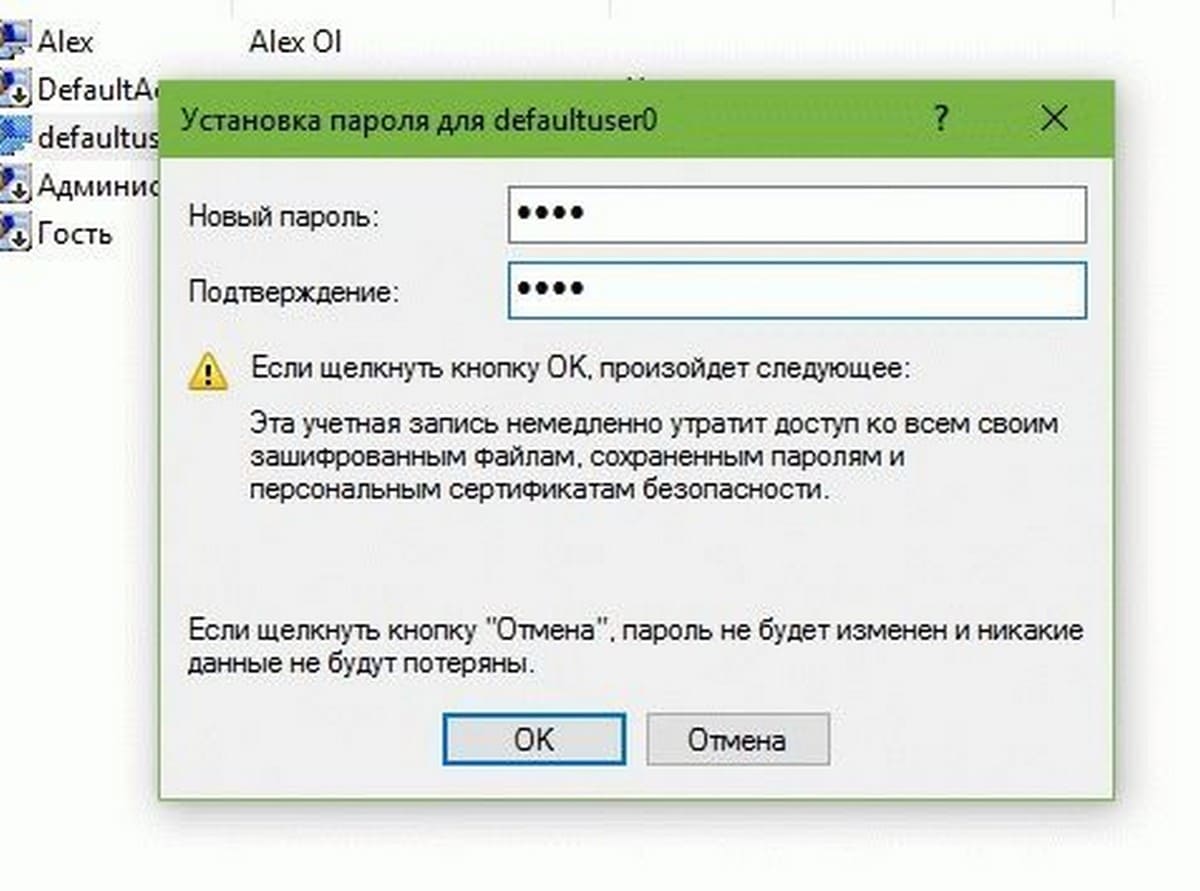
5. Вы получите подтверждение того, что был установлен пароль для defaultuser0, теперь вы можете расслабиться. Перезагрузитесь в нормальный режим работы.
Что такое учетная запись и пароль defaultuser0?
Defaultuser0 — это системный профиль пользователя по умолчанию до создания каких-либо учетных записей пользователей при настройке Windows. При первой перезагрузке после установки Windows учетная запись defaultuser0 должна быть удалена автоматически. Такого пароля defaultuser0 не существует. Поскольку учетная запись defaultuser0 уже зашифрована.
Что делать, если вы застряли с паролем учетной записи defaultuser0?
Вообще говоря, вы можете сбросить пароль user0 по умолчанию, удалите учетную запись пользователя defaultuser0 и создайте новую учетную запись на своем компьютере. Если вы не хотите переустанавливать компьютер, вы можете воспользоваться приведенными ниже способами устранения неполадок с паролем по умолчаниюuser0.

- Часть 1. Сброс забытого пароля Windows
- Часть 2: Как исправить пароль Defaultuser0 в Windows 10
- Часть 3: Часто задаваемые вопросы о пароле Defaultuser0
Часть 1. Сброс забытого пароля Windows
Если вы забыли длинный пароль и хотите обойти экран пароля defaultuser0, вы можете использовать imyPass сброс пароля Windows чтобы попасть в заблокированный компьютер. Программа способна сбросить учетную запись администратора Windows/стандартную учетную запись пользователя/пароль defaultuser0 без потери данных. Записав загрузочный диск простым щелчком мыши, вы можете пропустить экран пароля defaultuser0 и создать новую учетную запись на своем компьютере с Windows 11/10/8/7.
4 000 000+ загрузок
Легко обойти экран пароля defaultuser0.
Удалить пароль для входа в Windows 10 без потери данных.
Запишите диск для восстановления пароля Windows с помощью привода CD/DVD или USB-накопителя.
Поддержка компьютеров под управлением Windows 10/8/7/Vista/XP/Server с BIOS или устаревшим режимом.
Как обойти пароль defaultuser0 в Windows 11/10/8/7:
Шаг 1Загрузите imyPass Windows Password Reset на работающий ПК с Windows. В главном интерфейсе вы можете выбирать между Создать CD/DVD для сброса пароля а также Создать флешку для сброса пароля. Выберите один в соответствии с вашим планом покупки. Затем вставьте пустой CD/DVD или USB-накопитель в работающий ПК с Windows. Когда запись диска с обходом пароля завершится, нажмите ХОРОШО и безопасно извлеките записанный диск. Шаг 2Подключите записанный диск к Windows 10 с экраном пароля user0 по умолчанию. Перезагрузите компьютер с Windows и нажмите кнопку F12 или же ESC ключ для активации Меню загрузки. Нажимайте клавиши со стрелками вверх/вниз, чтобы выбрать вставленный диск на экране меню загрузки. Выделив его, нажмите кнопку Войти ключ. Теперь вы можете сохранить изменения и выйти из интерфейса. Затем ваш компьютер с Windows с экраном пароля defaultuser0 автоматически перезагрузится. Шаг 3Перенаправляемся в интерфейс этой программы и выбираем текущую операционную систему. Под Выберите пользователя меню выберите учетную запись пользователя, пароль которой вы забыли. Нажмите кнопку Сброс пароля кнопку ниже и подтвердите, нажав Да кнопка. После процесса сброса пароля извлеките записанный диск и перезагрузите компьютер с Windows, чтобы восстановить доступ без пароля user0 по умолчанию.
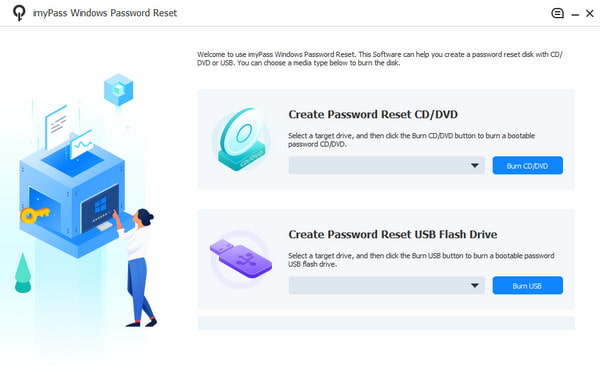
Часть 2: Как исправить пароль Defaultuser0 в Windows 10
Если Windows 10 все время запрашивает пароль defaultuser0, вы можете попробовать следующие способы решения проблемы.
Способ 1: перезагрузить компьютер, чтобы обойти пароль Windows 10 Defaultuser0
Перезагрузка компьютера — это самый главный и простой способ решить большинство проблем Windows. Вы можете перезагрузить компьютер с Windows, чтобы обойти пароль user0 по умолчанию. Если ваша Windows зависла на экране входа в систему, вы можете постоянно нажимать кнопку питания, чтобы принудительно завершить работу и перезагрузить компьютер. Продолжайте перезагружать Windows, пока не сможете настроить собственную учетную запись.
Способ 2. Сбросьте этот компьютер для устранения неполадок с паролем Defaultuser0
Если перезагрузка Windows не помогает, вы можете сбросить компьютер до заводских настроек. Будут удалены не только учетные записи пользователей, но и установленные приложения и личные настройки. Таким образом, вы можете удалить defaultuser0 после успешного сброса настроек.
Шаг 1Держите Сдвиг кнопку на клавиатуре. При этом нажмите кнопку Сила на экране входа в Windows. Шаг 2Продолжайте нажимать Сдвиг ключ. Нажмите Запустить снова на экране компьютера одновременно. Не выпускайте его, пока не получите доступ Расширенный вариант восстановления. Шаг 3Выбирать Устранение неполадок с последующим Удалить все для очистки диска Windows. Шаг 4Теперь вы можете войти в свой компьютер без ввода пароля Windows 10 defaultuser0.
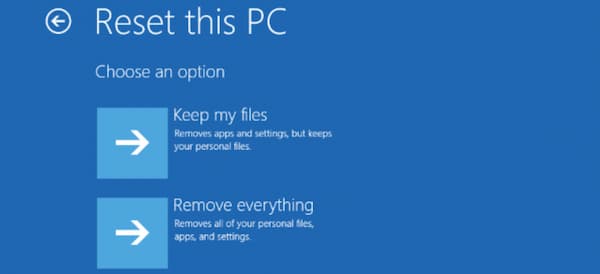
Способ 3: войдите в безопасный режим с помощью командной строки, чтобы решить проблемы с паролем Defaultuser0
Вы также можете устранять проблемы с паролем defaultuser0 с правами администратора. Кроме того, вы можете создать новую учетную запись с помощью командной строки после отключения пароля defaultuser0 в Windows.
Шаг 1Нажмите на экран Сила на экране входа в Windows. Вам нужно удерживать Сдвиг ключ одновременно. Шаг 2При этом нажмите кнопку Запустить снова кнопка, чтобы увидеть Расширенный вариант восстановления. Шаг 3Выбирать Устранение неполадок, дополнительные параметры, параметры запуска и перезагрузка. Шаг 4Нажимать F6 или же 6 на клавиатуре, чтобы выбрать Включить безопасный режим с помощью командной строки. Шаг 5Выбирать Администратор если вас попросят. Шаг 6Если вы хотите создать новую учетную запись, вы можете ввести чистый пользователь <username /добавлять в командную строку.
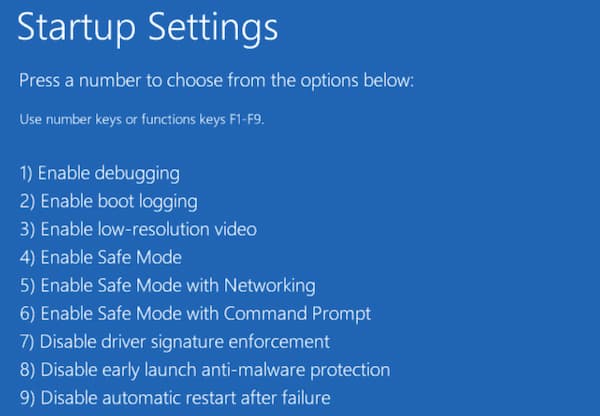
Способ 4: удалить учетную запись с паролем Defaultuser0
Если вы не хотите загружать Windows в безопасном режиме, вы также можете удалить профиль defaultuser0 с помощью панели управления. Позже вы можете добавить нового пользователя на свой компьютер с Windows.
Шаг 1Перейти к Windows Панель управления. Шаг 2Выбрать Учетные записи пользователей вариант. Шаг 3Нажмите Удалить профиль чтобы удалить учетную запись defaultuser0 в Windows.
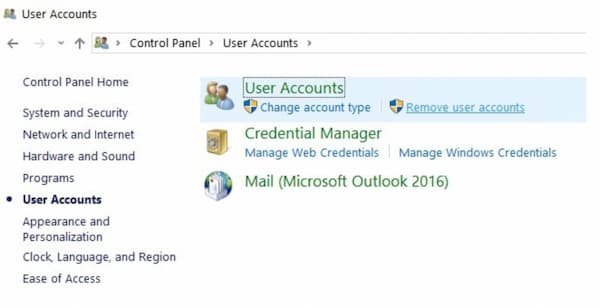
Часть 3: Часто задаваемые вопросы о пароле Defaultuser0
Можете ли вы установить пароль для входа в систему для defaultuser0?
Да. Щелкните правой кнопкой мыши Этот компьютер вариант. Выбирать Управление, локальные пользователи и группы, а также Пользователи. В контекстном меню defaultuser0 выберите Установка пароля. Затем нажмите Продолжить и введите пароль defaultuser0. Нажмите ХОРОШО чтобы сохранить изменения.
Можно ли скрыть учетную запись defaultuser0?
Да. Выбирать Запустить от имени администратора от Командная строка контекстное меню. Тип чистый пользователь defaultuser0 / Active: нет в командной строке. Нажимать Войти на клавиатуре для подтверждения. Позже вы сможете войти на свой компьютер с Windows без учетной записи defaultuser0 и пароля.
Как обойти новую учетную запись defaultuser1 при запуске после последнего обновления Windows?
Вы можете удалить и скрыть учетную запись defaultuser0 с помощью описанных выше методов устранения неполадок. Или вы можете выполнить восстановление системы, чтобы полностью вернуть компьютер Windows в предыдущее состояние.
Вывод
Это все, чтобы удалить пароль по умолчаниюuser0 на Windows 10 успешно. Вы можете создать локальную и стандартную учетную запись пользователя для управления настройками системы. Если вы забыл пароль Windows 10, вы можете обратиться к imyPass сброс пароля Windows для помощи. Все виды проблем с забытым паролем Windows можно прекрасно решить.
Подробнее Чтение
- 2 способа восстановить заводские настройки ноутбука HP без пароля в Windows 10/8/7
- 4 лучших способа легко сбросить пароль Windows 7
- Учебник по входу в Windows 10 без пароля администратора
Provide feedback
Saved searches
Use saved searches to filter your results more quickly
Sign up
Users having Windows 10 might have noticed that when they go to users directory (C:\Users), there is an user profile named with ‘defaultuser0‘. If you’re an active part of Windows Insider program, you might have even seen this defaultuser0 on sign-in screen of some builds. Now the question is – why is this ‘defaultuser0‘ account present in Windows 10 and should you care about it?
Page Contents
What Is ‘defaultuser0’ Account in Windows 10 And Why Should You Care About It?
The defaultuser0 is nothing but a small bug present in Windows 10 builds. Some systems may show it is defaultuser(). It is an user account neither part of any user group nor it have any profile. Considering these facts, it is actually safe to remove it.
But you might be thinking what will occur if you don’t remove it?
Well from past experiences, it has been observed that sometimes this defaultuser0 can create complex situations for you, like:
1. You performed Reset to Windows 10 and your account is lost. Then Windows 10 forces you to login as ‘defaultuser0‘ (below mentioned image illustrates this). But there is no password set for that user account and you’re stuck. From this point, you’ve only option left is to make a clean install by wiping your data and wasting your time.
2. In some cases, defaultuser0 again appears on clean install and there might be repetition of what I said in point 1.
How To Remove Or Fix ‘defaultuser0’ Account In Windows 10?
Since the ‘defaultuser0‘ can be safely removed, the best bet is to remove it as soon as you realize that it is present. However, if you feel that you want to keep that account, it is necessary that you set a know password for it. Both ways are mentioned here.
Option 1 – Remove ‘defaultuser0’ Completely
1. Boot Windows 10 into Safe Mode.
2. Open lusrmgr snap-in by running lusrmgr.msc command. Click here if you can’t open the snap-in.
3. Click on Users folder and right click on defaultuser0 entry. Select Delete. Close lusrmgr snap-in.
4. Also delete the defaultuser0 folder from C:\Users (replace C: with your system root drive).
Registry Disclaimer: The further steps will involve registry manipulation. Making mistakes while manipulating registry could affect your system adversely. So be careful while editing registry entries and create a System Restore point first.
5. Press + R and put regedit in Run dialog box to open Registry Editor (if you’re not familiar with Registry Editor, then click here). Click OK.
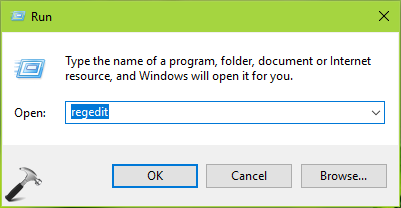
6. In left pane of Registry Editor window, navigate to following registry key:
HKEY_LOCAL_MACHINE\SOFTWARE\Microsoft\Windows NT\CurrentVersion\ProfileList
7. Expand ProfileList registry key, you’ll see some sub-keys beginning with S-1-5…. Highlight each sub-keys one by one and in the right pane, look ProfileImagePath registry string (REG_EXPAND_SZ). The data corresponding to it should help you to decide which is correct registry SID sub-key for defaultuser0. When you spot the exact one, right click on it and select Delete. Close Registry Editor. Reboot to normal mode.
In this way, defaultuser0 account is removed.
Option 2 – Set A Password For defaultuser0
If you’re not comfortable in deleting defauluser0, you can go with these steps to set a password for it.
1. Follow steps 1 and 2 of Option 1.
2. In lusrmgmr window, click on Users folder and right click on defaultuser0 entry, select Set Password option.
3. Then click Proceed here:
4. Then type in a new and simple+easy to remember password and confirm it. Click OK.
5. You’ll get confirmation that password has been set for defaultuser0 and you can now relax. Reboot to normal mode.
So that’s all about defaultuser0!
Related: What Is ‘DefaultAccount’ In Windows 10?
RELATED ARTICLES
The Defaultuser0 account is a temporary Windows 10 profile used to complete the Windows installation. This profile is usually deleted when the first user profile is created after a successful Windows installation.
If due to any reason, this profile could not be deleted and the user was not able to create his profile after the Windows installation (e.g. due to sudden power failure), then he may be shown a defauluser0 profile on the next system launch. This profile is a Windows-based profile and not for the use of PC users.

Also, this account does not have any associated password with it and no password can be used to log into the system, thus the user gets locked out of the system if he sees this as the only profile after either updating or installing Windows.
How to Remove Defaultuser0 Profile and get Access to a Profile?
The defaultuser0 password issue is usually caused by an unfinished Windows setup due to an unexpected system shut down during the process. This can occur after the new installation of the OS, during resetting of the PC, or updating it.
Use the Boot Menu Key to Re-Initiate the Installation Setup
Defaultuser0 password is created when the Windows installation is not finalized and using the boot menu key (like F2 or F12 on an Asus machine) may trigger the completion of the pending installation, thus solve the problem.
- Firstly, power off your machine.
- Now power on the machine and immediately start pressing the boot menu key like F2 or F12 key on an Acer machine.
- Then check if the first-time startup menu is shown where a user creates his login ID.
- If so, then use that to complete your login set up, and afterward, check if the defaultuser0 issue is resolved.
Revert the System to the Previous Build of Windows
If you are seeing the defaultuser0 password issue after a Windows update, then most probably the update could not be properly applied to your system or the update is not compatible with your system. In such a case, reverting to the previous Windows 10 build may solve the problem.
- Hold the left Shift key on the login screen and click on the Power icon in the bottom right of the screen.
- Now click on Restart and keep holding the Shift key until you reach Windows Recovery Environment. Now choose Troubleshoot.
Open Troubleshoot in Advanced Startup Menu - Then open Advanced Options and select Go Back to the Previous Build.
Open Advanced Options in the Startup Menu - Now follow the prompts to complete the revert process and afterward, check if the defaultuser0 password issue is cleared.
Go Back to the Previous Build of Windows 10
Set Password on the Defaultuser0 Account in the Safe Mode of Your System
As the defaultuser0 does not have a password associated with it, setting a password on the said account and using that to log in into the system may solve the problem. But this option will only be available to some of the lucky users.
- Boot your system into the Windows Recovery Environment (as discussed above) and navigate to the Troubleshoot > Advanced Options > Startup Settings and click on the Restart button.
Open Startup Settings in the Advanced Options - Now, in the Startup Settings window, press the 4 key to boot the system into the Safe Mode.
Boot Your System into Safe Mode - Once in the Safe Mode, right-click on Windows and select Run.
Open the Run Command Box from the Quick Access Menu - Then execute the following in Run:
lusrmgr.msc
Open Local User & Groups Manager from the Run Box - Now, in the left pane of the Local Users and Groups window, head to the Users folder, and afterward, in the right pane of the window, right-click on the Defaultuser0.
Set Password on the Defaultuser0 Account - Then select Set Password and in the warning box, click on Proceed.
Click on Proceed to Set a Password on the Defauluser0 Profile - Now type in your new password and then confirm the entered password.
Enter and Confirm a New Password for the Defaultuser0 Profile - Once the password reset confirmation message is received, boot your system into the normal mode and check if you can log in using the newly entered password.
Use the Command Prompt to Enable the Built-in Administrator Account or Remove the Defaultuser0 Profile
As you cannot bypass the login screen of the PC, using the Command Prompt to create another user or activating the built-in administrator account may solve the problem.
Use Safe Mode to Enable the Built-in Administrator Account
- On the login screen of your system, click on the Power icon.
- Now hold the left Shift key and click on Restart while keep holding the Shift key until you see the Windows Recovery Environment.
Hold the Shift Key and Click on Restart - Then select Troubleshoot and open Advanced Options.
- Now select Startup Settings and click on the Restart button.
- Then the system will reboot and upon reboot, on the screen of Startup Settings, press 6 to start your system in the Safe Mode with Command Prompt.
Boot Your System into the Safe Mode With Networking - Once the Command Prompt window is shown, execute the following two commands one by one:
net user Administrator passwordofyourchoice net user Administrator /active:yes
Activate Local Administrator from the Command Prompt - Now exit the Command Prompt and boot your system into the normal mode.
- Once on the login screen, log in using your built-in administrator account with the password you chose and check if that resolves the issue.
Remove the Defaultuser0 Profile by Using the Bootable Media
If the safe mode method does not work, then you may use a bootable device media to remove the Defaultuser0 profile.
- Firstly, create a bootable Windows 10 USB on another system or use a Windows 10 DVD.
- Now boot your system through that bootable media.
- Then select the correct keyboard layout and date/ time.
- Now, on the next screen, click on Repair Your Computer in the bottom left corner.
Click on Repair Your Computer - Then select the Troubleshoot option and open Advanced Options.
- Now select Command Prompt and execute the following one by one (where C is your system drive, you may have to find the letter for your system drive):
C: Dir CD Users Ren defaultuser0 dummyuser
- Then exit the Command Prompt and restart your computer.
- Upon restart, boot your system through the internal drive (not the bootable disc or USB), and upon boot, check if the defaultuser0 login issue is resolved.
Use a Bootable Device Media to Enable the Built-in Administrator Account or Create Another Account
If the safe mode method does not work, then you may use a bootable device media to enable the built-in administrator or create another user account.
- Follow steps 1 to 6 of the above method to open the Command Prompt from a Bootable device.
- Then, in the Command Prompt, execute the following:
net user administrator /active:yes
Activate Local Administrator from the Command Prompt - Then exit the Command Prompt and restart your computer.
- Upon restart, boot your system through the internal drive (not the bootable disc or USB), and upon boot, check if you can bypass the defaultuser0 login by logging into the built-in administrator. If so, then you may create another administrator account and disable the built-in administrator. If you want to, you may remove the defaultuser0 profile.
- If you cannot access the Command Prompt at step 2, then boot your system from the bootable media and navigate to the Advanced Options screen.
- Now, without powering off your system or clicking on any button, simply disconnect the bootable media device.
- Then, on the Advanced Options screen, click on Command Prompt and when the Command Prompt shows, reconnect the bootable device and execute the following:
net users (NewUserName) (password: optional) /add
- Now exit the Command Prompt and restart your system
- Upon restart, check if you can log into the system by using the newly created account. If so, then you may remove the defaultuser0 profile.
Rename the Command Prompt as Ease of Access to Show on the Login Screen
If none of the above did the trick for you, then you may use a nifty trick to rename the Command Prompt as Ease of Access (utilman.exe), so that it shows on the login screen and you can use it to set the password on the defaultuser0 account.
- Boot your system through the USB boot media or DVD drive and follow the prompts till you are on the installation screen (where you click Install to start the installation of Windows).
Press Shift+F10 Keys to Open Command Prompt on the Installation Screen of Windows - Now press the Shift + F10 keys to open the Command Prompt and when the Command Prompt window is shown, you may execute the following one by one (where C is the system drive, you may have to find the letter for your system drive):
C: dir windows\system32 ren utilman.exe utilman1.exe ren cmd.exe utilman.exe
- Now close the Command Prompt and reboot your system through the internal drive (not the external boot device).
- Upon reboot, when you are at the login screen, click on the Ease of Access icon at the right bottom.
Click on the Ease of Access Button on the Login Screen - Now, when the Command Prompt window is shown, type the following and hit Enter:
net user - Then check how the defaultuser0 is shown there.
- Then type the following with the noted defaultuser0 profile name followed by your password (e.g., password123), do not worry, if your input is not shown on the screen:
net user defaultuser0 password123
- Then verify the password (if asked to) and exit the Command Prompt.
- Now login to the defauluser0 profile with the newly created password and check if the issue is resolved. If so, then you may rename back the utilman.exe and cmd.exe to their originals.
Reset Your PC to the Defaults
As the above-mentioned methods did not work for you, then you may have to reset your PC to the defaults after backing up your data (if essential) to solve the problem.
Use the System’s Windows Recovery Environment
- Firstly, backup your data from the system. You can connect your system’s drive to another system or use a live bootable USB of Ubuntu on the system to back up its data.
- Once the data is backed up, boot up your system into Windows and when you are at the login screen, click on the Power icon.
- Now hold the Shift key and click on Restart.
- Then keep holding the Shift key until the Windows Recovery Environment is shown and select Troubleshoot.
- Now click on Reset This PC and select Remove Everything (make sure you fully clean the drive).
Click on Reset This PC - Then follow the prompts to complete the Reset process and afterward, check if the defaultuser0 password issue is resolved.
Select Remove Everything on the Reset This PC Screen
Use the Windows Recovery Environment from a Bootable Device
If you cannot use the system’s Recovery Environment, then doing the same from a bootable media may do the trick.
- Boot your system through a bootable device (as discussed in the earlier solutions).
- Now select the correct date, time, and keyboard layout.
- Then, on the next window, select Repair Your Computer (near the bottom left of the screen) and on the next screen, choose Troubleshoot.
- Now select Refresh Your PC or Reset Your PC.
Open Troubleshoot in Advanced Startup Menu - Then follow the prompts to complete the process and afterward, check if the defaultuser0 password issue is resolved.
If none of the above did the trick for you, then you may use a Linux Live USB to reset the password on the defaultuser0 account (how? Internet is your best friend) or perform a clean installation of Windows. But before doing the reinstallation, make sure for the following, otherwise, you may encounter the defaultuser0 issue again:
- If your laptop has a dead battery, please remove it from the laptop before doing the clean installation.
- Make sure that the BIOS of your system is updated to the latest build and then reset it to the factory defaults.
- Check if the time in the BIOS is correct. Also, do not forget to replace the CMOS battery, if the system time and date become incorrect after a system shut down.
Kevin Arrows
Kevin Arrows is a highly experienced and knowledgeable technology specialist with over a decade of industry experience. He holds a Microsoft Certified Technology Specialist (MCTS) certification and has a deep passion for staying up-to-date on the latest tech developments. Kevin has written extensively on a wide range of tech-related topics, showcasing his expertise and knowledge in areas such as software development, cybersecurity, and cloud computing. His contributions to the tech field have been widely recognized and respected by his peers, and he is highly regarded for his ability to explain complex technical concepts in a clear and concise manner.



















